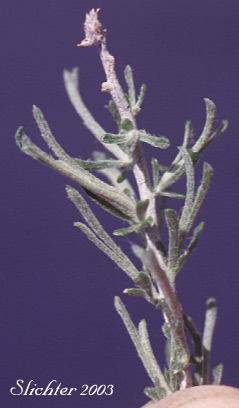 The
photo at right shows a tip of a leafy branch of stiff sagebrush on Gerking Hollow
Road, south of Rufous, OR...........April 9, 2000.
The
photo at right shows a tip of a leafy branch of stiff sagebrush on Gerking Hollow
Road, south of Rufous, OR...........April 9, 2000.
Stiff sagebrush is a shrubby species with pungent sagebrush taste and odor. It is low in height, growing up to 50 cm with the many stems rigid and many-branched. It has a somewhat rounded form. Plants exposed to fire do not resprout. The newer twigs range from glabrous and yellowish to brownish in color to covered with fine white-woolly hairs. Older twigs are covered with a dark, stringy-fibrous bark. The plants are deciduous, commonly lose their leaves by late fall. The leaves range from 1-5 cm long with 3-5 long, thin narrow segments (See photo at right.). The leaves are cleft about half their length or less. Leaves of the upper stems may often be entire, lacking the thin segments.
The inflorescence is a narrow spike with the flower heads or clusters of flower heads sessile in the leaf axils. The subtending leaves are much longer than the flower heads. The involucre ranges from 4-5 mm high and is covered with dense, white hairs. Stiff sagebrush flowers from September to October.
The seeds are eaten by mice, ground squirrels, rabbits and sage grouse. The Nez Perce used the bark and leaves to make a tea to treat tuberculosis.
Stiff sagebrush may be found on dry, rocky sites in the plains and foothills, often in soils less than 25 cm deep.
Stiff sagebrush may be found from central Washington and central Oregon east to western Montana.
